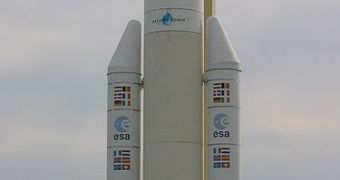In addition to launching two observatories at the same time, the May 14th launch event, scheduled to take place at the European Space Agency's (ESA) Kourou spaceport, in the French Guyana, will also see the first time the new horizontal separation system HSS-3 being used. It was designed specifically to reduce the mechanical forces that act on the payload upon separation, when the protective cover that shelters the satellites is no longer necessary and is jettisoned. If ESA engineers got it right, then the new system will reduce the amount of force exerted on the Herschel and Planck space telescopes by a factor of about 100.
The HSS-3 system, which was developed by the Oerlikon Space company, is solely responsible for the correct separation between the Ariane 5 delivery system carrying the two satellites and the protective fairing, which becomes expendable about two minutes into the flight, when the rocket reaches an altitude of about 120 kilometers (74.5 miles). Naturally, if anything is to go wrong, then the very precious cargo, which took years to design, build and test, could be completely compromised.
The two observatories that will launch on May 14th underwent extensive testing, as engineers attempted to ensure that the stress they would experience upon separation did not damage their very intricate and delicate circuitry. The spacecraft were designed to work in the L2 point, a location about 1.5 million kilometers beyond the orbit of the Earth and the Moon. They will conduct their operation at subzero temperatures, and, if any damage is to come to their nitrogen cooling system, all the efforts would have been for nothing.
The innovation that Switzerland-based Oerlikon Space proposed for its new device was simple and ingenious – namely to design HSS-3 in such a manner that the shocks it generated canceled each other out. The way company engineers accomplished that was by creating two concentric rings, which were attached to each other in a very “shock-absorbing” way. As the enterprise's head of development of payload fairings Jean-Pierre Schwander put it, “The shock at the separation of the fairing is no longer an issue.”
The separation system itself was tested on two occasions at NASA’s Plum Brook Station research center in Ohio, USA, which hosts the largest vacuum chamber in the world. Oerlikon Space engineers accumulated a lot of knowledge on how the system behaved the first time, and then seriously tweaked another version, for the second test. In short, they are very confident that the HSS-3 will work.

 14 DAY TRIAL //
14 DAY TRIAL //